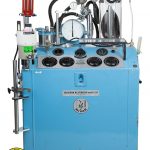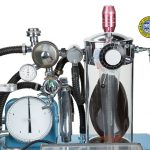Engstrom Model 150
Anesthesiologists may use muscle relaxant drugs to provide good operating conditions during surgery. While in this state, the patient's breathing is done for him or her by the anesthesiologist. Introduced in 1942, the use of muscle relaxants increased over the next decades, often becoming part of general anesthesia. The growing need for ventilation during anesthesia coincided with the world-wide spread of poliomyelitis, or polio. Thousands of polio survivors needed a respirator of their own to be able to breathe. Anesthesiologists sought a way to reduce the complication of this additional equipment in the operating room.
Swedish physician Carl Gunnar Engstrom, M.D. (1912-1987) filed to patent a new respirator in 1950. Four years later, the Engstrom Universal Respirator, also called the Model 150, was introduced. It was the first mechanical ventilator that could also deliver inhalation anesthetics. Like the Emerson Respirator, it applied both positive and negative pressure to the patient’s lungs, but did this more gradually. Mechanical ventilators soon became a standard feature of all anesthesia machines, improving patient safety. This example of the Engstrom Respirator has been modified by the addition of a Draeger Vapor halothane vaporizer.
Catalog Record: Engstrom Model 150
Access Key: amel
Accession No.: 2012-01-06-3
Title: Engstrom Respirator Modell 150.
Author: Engström, Carl-Gunnar, 1912-1987.
Title variation: Alt Title
Title: Engstrom Universal Respirator Model 150.
Title variation: Alt Title
Title: Engstrom Universal Ventilator Model 150.
Publisher: Stockholm, Sweden : MIVAB Elektromedicinska Aktiebolog, [between 1953 and 1974].
Physical Descript: 1 ventilating anesthesia machine : metals, plastics, rubber ; 153 x 106 x 61 cm.
Subject: Anesthesia Machines.
Subject: Anesthesia – history – Sweden.
Subject: Poliomyelitis – history.
Subject: Ventilators, Mechanical.
Note Type: General
Notes: The date range is based on the known date of introduction and date when a new
generation [the 2000 series] was introduced.
The undated brochure titled “The Engstrom Respirator” is kept in the Engstrom
Company vertical file.
Note Type: With
Notes: George S. Bause, M.D., Honorary Museum Curator, in conversartion with the
cataloger, recalled that the previous owner refurbished the machine prior to
donating it to the WLM, and may have added the vaporizer at that time.
Note Type: Citation
Notes: Engstrom C-G. Treatment of severe cases of respiratory paralysis by the
Engstrom Universal Respirator. Br Med J. September 18, 1954;2(4889):666-669.
Note Type: Citation
Notes: Engstrom, C-G. The Clinical Application of Prolonged Controlled Ventilation:
With Special Reference to a Method Developed by the Author. Stockholm:
Aarhuus Stiftsbogtrykkerie; 1963.
Note Type: Citation
Notes: Gedeon, Andras. Science and Technology in Medicine. New York: Springer; 2006.
Note Type: Citation
Notes: McPherson SP. Respiratory Therapy Equipment. St. Louis: C. V. Mosby Company;
1977.
Note Type: Citation
Notes: MIVAB el. med.ab. The Engstrom Respirator. Stockholm: MIVAB el. med.ab., date
unknown. Archives. Located at: Wood Library-Museum of Anesthesiology,
Schaumburg, Illinois.
Note Type: Citation
Notes: Mushin WM, Rendell-Baker L, Thompson PW. Automatic Ventilation of the Lungs.
2nd ed. Oxford: Blackwell Scientific Publications; 1969.
Note Type: Citation
Notes: Mushin WL, Rendell-Baker L, Thompson PW and Mapleson WW. Automatic
Ventilation of the Lungs. 3rd ed. Oxford: Blackwell Scientific Publications;
1980.
Note Type: Physical Description
Notes: The cabinet is made of metal that has been painted or enameled a sky blue
color; Each of the four wheels is equipped with a lever that acts as a brake
when engaged;
Mounted on the top of the cabinet, from left to right, are: 1) a short
cylinder, made of the same metal as the cabinet, with three connecting ports,
one of which holds a black corrugated hose that leads to the central
assembly; 2) An empty armature; 3) A rectangular housing, made of the same
metal as the cabinet, holds a large round gauge marked “1, 2, 3, 4, 6
Liters”; This is connected by one black corrugated hose to the short cylinder
and by a second such hose to the central assembly; 4) An assembly of several
components with hoses that connect it to other parts of the machine, and one
hose that is not connected to anything else; These components include a
narrow chrome cylinder, a gauges and two dials; The dial at the upper right
is marked “Automatic Vent, Manual Vent”; The dial at the lower right is
marked “Breathing Position [new line] Spirometer [new line] Venturi, Danger”;
The gauge at lower left is marked “cm H2O”, with graduation marks in
ten-degree increments from 30 to 0 and from 10 to 60; 5) A large, clear
plastic cylinder that houses the ventilator containing a rebreathing bag; On
the front of the ventilator, near the top of the cylinder, is a control dial
with three settings, marked “Rebreathing, Filling, Nonrebreathing”; Mounted
on the top of the ventilator is a small red metal canister, marked “Danger
[new line] Watertrap Off [new line] Release at Max Pressure [new line] [left
arrow] 70 cm H2O” (the top of this canister is the highest point on the
machine);
Other controls for the unit are mounted on an angled front panel, between the
horizontal top of the unit and the vertical front panel; From left to right
the angled panel holds 1) a metal block with three hose connection ports and
a dial (this block bears a Dynatape label that reads: “Machine”), 2) the
“pressure regulator” knob, 3) a round window that might have been intended to
hold a gauge, 4) the “selector switch” knob, 5) the “frequency of respiration
per minute” knob, 6) the “dosing valve calibration” knob, 7) a gauge for “cm
of H2O”, 8) the manometer on-off knob, 9) a knob marked “emtying [sic]
pressure for the rubber bag”; The “frequency of respiration” knob is in the
center of the panel; below this a label reads: “Do Not Turn [new line] Dial
Unless [new line] Motor is Running [new line] Schick X-Ray, Chicago”; The
manometer on-off knob is at the upper right of the panel; Above this a label
reads: “Caution! [new line] Do Not Allow Explosive Gases or [new line]
Vapours to Enter the Respiration Bag” …. [Continued]
Note Type: Physical Description
Notes: [Continuation]… Mounted on the right side of the angled front panel are two
brackets that hold a horizontal shelf made of a single piece of clear
plastic; The shelf is set in a metal frame; The plastic measures 35.5 x 21.5
cm;
There are two labels on the vertical front panel; The upper, larger label
reads: “Engstrom Respirator Modell [sic] 150 [new line] Patented Made in
Sweden”; directly below this appears a round label bearing the name and logo
of the manufacturer: “MIVAB”;
Mounted on the left front corner of the angled panel is a post that holds a
Draeger Vapor vaporizer; The two black rubber hoses that are a part of the
vaporizer are not attached to the machine;
A second post behind the vaporizer holds a vertical flowmeter with three
tubes, marked “O2, O2, N2O”; The housing for the flowmeter is made of a red
metal;
Set into the left wall of the cabinet is a round window marked “Stunden [new
line] 110 V 60 ~”; This contains a mechanism with slots for a total of six
digits; Currently, the number registered is 0915679;
A clear corrugated plastic hose is attached by a clip to the right wall of
the cabinet; This holds a large H-shaped connector; each of the long arms of
the H terminates in a valve; The center piece of the H terminates in a dial
marked “Expir. Pressure [new line] O [left arrow] Max“;
Set into the right wall of the cabinet are two ports for connecting to a
piped gas system, marked “N2O” and “O2”, respectively;
A stout black handle is mounted on the left wall and another on the right
wall of the cabinet, to facilitate moving the machine;
On the back wall of the cabinet, in the upper left corner, a label reads:
“MIVAB Elektromedicinska Aktiebolag [new line] Luntmakargatan 12 – Stockholm
[new line] Tel. 10 47 72 [new line] M 985 H 847 [new line] V 220 W 600 [new
line] Vaxelstrom”; To the right of this, another, larger label holds a
diagram titled “Lubrication Chart” and a list of instructions for the
lubrication of the apparatus.
Note Type: Reproduction
Notes: Photographed by Mr. Steve Donisch, January 14, 2015.
Note Type: Acquisition
Notes: The donor’s name and the date of acquistion have not been determined. The
machine was in the WLM collection by January 1, 1999. The machine was given
an artificial accession number during the inventory conducted in 2013.
Gerorge S. Bause, M.D., Honorary Museum Curator, in conversatrion with the
cataloger, recalled that it was donated by a private practive of
anesthesiologists in Illinois.
Note Type: Historical
Notes: Anesthesiologists may use muscle relaxant drugs to provide good operating conditions during surgery. While in this state, the patient’s breathing is done for him or her by the anesthesiologist. Introduced in 1942, the use of muscle relaxants increased over the next decades, often becoming part of general anesthesia. The growing need for ventilation during anesthesia coincided with the world-wide spread of poliomyelitis, or polio. Thousands of polio survivors needed a respirator of their own to be able to breathe. Anesthesiologists sought a way to reduce the complication of this additional equipment in the operating room.
Swedish physician Carl Gunnar Engstrom, M.D. (1912-1987) filed to patent a new respirator in 1950. Four years later, the Engstrom Universal Respirator, also called the Model 150, was introduced. It was the first mechanical ventilator that could also deliver inhalation anesthetics. Like the Emerson Respirator, it applied both positive and negative pressure to the patient’s lungs, but did this more gradually. Mechanical ventilators soon became a standard feature of all anesthesia machines, improving patient safety. This example of the Engstrom Respirator has been modified by the addition of a Draeger Vapor halothane vaporizer.
Note Type: Exhibition
Notes: Selected for the WLM website (noted October 1, 2015).



